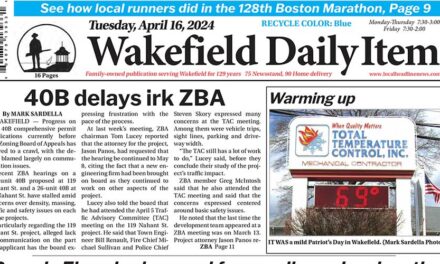By MARK SARDELLA
WAKEFIELD — The School Department recently received notice that this year the state will reimburse special education costs through its Circuit Breaker program at a rate of 65 percent of the district’s net claim, down from 73 percent last year.
School Business Administrator Michael Pfifferling called the reduction “disheartening.” He told the committee Tuesday that had the percentage come in higher, “It certainly would have helped with our special education costs this year.”
In response to a question from School Committee member Greg Liakos, Pfifferling said that special education costs have been a concern for school districts across the state, but noted that Wakefield has recently had some very severe cases that needed to go out of district, including several residential placements.
“That’s why Circuit Breaker is there,” Pfifferling added. “Circuit Breaker is there to protect the district from these large cases that go out of district.”
He noted that Wakefield’s net claim under Circuit Breaker has more than doubled since FY 2014 when it was $913,740. This year’s net claim is $2,101,334, which at this year’s 65 percent reimbursement would come to $1,365,868.
School Superintendent Dr. Kim Smith added that the escalating costs are not unique to Wakefield. She said that some of the added special education costs are related to several families that moved into the district this year.
“Of course, we welcome all of our families,” she said, but acknowledged the impact on the special education budget.
School Committee member Thomas Markham said that Wakefield’s state legislators should be urged to support Circuit Breaker funding. Pfifferling noted that when Circuit Breaker was introduced in 2004, it was intended that reimbursement would be at 75 percent, but it has rarely hit that point.
For background, Pfifferling included in each School Committee member’s meeting packet the following “primer” on how the state’s special education Circuit Breaker program works. He incorporated some information from the state DESE along with some local specifics.
“The following is document was prepared for School Committee members to help explain how Circuit Breaker Reimbursement is distributed by DESE:
The state special education reimbursement program, commonly known as the circuit breaker program, was started in FY04 to provide additional state funding to districts for high-cost special education students. The threshold for eligibility is tied to four times the state average foundation budget per pupil as calculated under the chapter 70 program, with the state paying a percent of the costs above that threshold as a reimbursement based on the previous year’s actual expenditures and DESE’s allowable costs. In FY17, the state average foundation budget per pupil was approximately $10,773.50, so if a special education student cost a district $100,000, the district’s eligible reimbursement for that student would be $36,988.90.
Circuit breaker reimbursements are for the district’s prior year’s expenses. Each summer, districts submit claim forms to DESE listing the types and amounts of special education instructional services provided to each student during the previous fiscal year. Administrative and overhead costs are not reimbursable. Standard rates for each type of service are established annually by DESE based on statewide surveys and are used to calculate the reimbursable cost for each student; this simplifies the claim process and minimizes the documentation which needs to be submitted. For students attending private schools, the eligible cost for reimbursement is based on the approved tuition rate set by the state’s Operational Services Division.
Payments are made to districts on a quarterly basis. After all the claim forms have been received and reviewed, and DESE verifies that there are sufficient appropriations to pay all claims, the reimbursements are recalculated using the determined percent rate for that year.
In addition to the regular circuit breaker reimbursements, the “extraordinary relief” program provides funding to help districts experiencing a significant increase in their special education costs. Under this program, districts may file an additional claim form in February for the current year’s estimated expenses. If the expenses have increased by 25 percent or more over the prior fiscal year, then the district will be eligible for an additional extraordinary relief payment to help fund the increase.
Circuit breaker claims are audited by DESE, and adjustments are made to future payments in the event of disallowed costs. The single biggest reason for costs being disallowed is that the services have not been clearly documented on the student’s Individualized Education Program (IEP). Only services that are required by the IEP are eligible for reimbursement.
Circuit breaker reimbursements are deposited into a special education revolving account. These funds may be expended by the school committee in the year received or in the following fiscal year for any special education-related purposes, without further appropriation. As with all special revenues, the appropriating authority can and should consider the projected reimbursements for the following fiscal year when deliberating on the school district’s general fund budget.
For FY17 claim (FY18 receipt), our claim included 34 students at a cost of $3,566,530. The foundation amount was $1,465,196 (4 * $10,773.50 * 34) leaving a net claim of $2,101,334. From the net claim, we will be reimbursed at 65 percent or $1,365,868. It is important to note that the Circuit Breaker fund is required to reimburse at 75 percent, but has not been funded at that level for several years. If it were fully funded in FY18, it would be $210,132 higher. In FY17, the reimbursement was 73.1566 percent.
For historical knowledge, our net claim and reimbursement for prior years are as follows:
FY, Net Claim, Reimbursement, % Reimbursement
FY18, $2,101,334, 65 percent, $1,365,868 FY17, $1,944,052, 73.16 percent, $1,422,203 FY16, $1,604,089, 75 percent, $1,203,067 FY15, $1,079,265, 73.5 percent, $793,920 (plus $282,526 in extraordinary relief) FY14, $913,740, 75 percent, $685,309 (plus $11,141 in extraordinary relief) FY13, $860,044, 74.5, percent, $641,565. As you can see, in FY18, we are receiving $56,335 less in Circuit Breaker Reimbursement than we did in FY17. We budgeted our FY18 reimbursement on the conservative side at $1,325,500 which will provide an additional $40,368 to slightly offset some of the unknown Special Education Tuition Costs for FY18.”




